Intel Bundle
Can Intel Reclaim Its Tech Titan Status?
Founded in 1968, Intel, a cornerstone of the tech industry, is navigating a pivotal moment marked by leadership changes and fierce competition. The company, once synonymous with cutting-edge processors, now faces a critical juncture as it strives to revitalize its Intel SWOT Analysis and reclaim its position in the market.
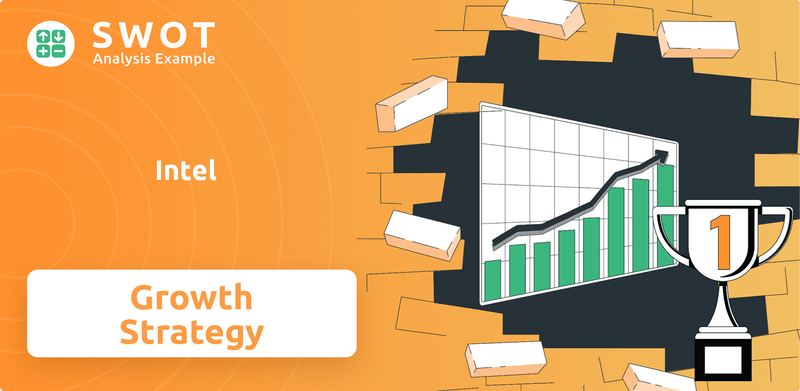
With the departure of its CEO and a rapidly evolving technological landscape, understanding Intel's growth strategy and future prospects is more crucial than ever. This analysis delves into Intel's strategic initiatives, exploring its plans to regain Intel market share, foster Intel innovation, and adapt its Intel business model to thrive in the semiconductor industry. We'll examine how Intel plans to compete with AMD, its investment in artificial intelligence, and its role in the autonomous vehicle market, providing a comprehensive view of the company's long-term vision and goals.
How Is Intel Expanding Its Reach?
To ensure future growth, Intel is actively pursuing several expansion initiatives. These initiatives are designed to diversify revenue streams and capitalize on emerging market opportunities. A significant focus area is the automotive market, which Intel has identified as a key growth driver. This strategic shift is part of Intel's broader plan to solidify its position in the semiconductor industry and enhance its long-term value.
Intel's expansion strategy includes significant investments in its foundry business. The company aims to become a major contract chipmaker, competing with established players in the semiconductor manufacturing space. These efforts are supported by substantial funding from the U.S. government, reflecting the strategic importance of domestic semiconductor manufacturing.
Intel is also making strategic acquisitions and developing new technologies to stay ahead of the competition. These moves are critical for maintaining and growing Intel's market share in a dynamic industry. The company's focus on innovation and strategic partnerships is essential for achieving its long-term goals and navigating the challenges of the semiconductor market.
Intel is targeting the automotive market as a major growth opportunity. At CES 2024, the company announced a strategic focus on the future of mobility. This includes the acquisition of Silicon Mobility, a company specializing in System-on-Chips (SoCs) for electric vehicle (EV) energy management. This positions Intel as a direct competitor in this market.
Intel unveiled a new series of AI-enhanced, software-defined vehicle SoCs. Zeekr is the first OEM to adopt this technology for AI-driven in-car experiences. Intel aims to deliver the industry's first open UCIe-based chiplet platform for software-defined vehicles. This allows for greater flexibility and customization.
Intel is heavily investing in its foundry business to become a major contract chipmaker. The 18A process node, expected to ramp in late 2025, is a critical part of this strategy. Intel has received significant funding under the U.S. CHIPS and Science Act to support domestic semiconductor R&D and manufacturing.
The foundry business recorded an operating loss of $2.3 billion in Q1 2025. Intel aims for the foundry business to break even by the end of 2027. This expansion is crucial for Intel's long-term growth and its ability to compete in the semiconductor market.
The automotive market represents a significant opportunity for Intel, as the company aims to dominate the future of mobility. This includes the acquisition of Silicon Mobility, which strengthens Intel's position in the EV sector. The development of AI-enhanced vehicle SoCs and an open UCIe-based chiplet platform further supports Intel's expansion in this market. For more information on Intel's target market, you can read this article: Target Market of Intel.
Intel's expansion initiatives are focused on diversifying revenue streams and capturing new market opportunities, particularly in the automotive sector. The company is investing in its foundry business to become a major contract chipmaker, supported by significant government funding. These efforts are designed to drive long-term growth and enhance Intel's competitive position.
- Strategic acquisitions, such as Silicon Mobility, to enter new markets.
- Development of AI-enhanced SoCs for the automotive industry.
- Significant investments in the foundry business and new process nodes.
- Government funding through the CHIPS and Science Act.
Intel SWOT Analysis
- Complete SWOT Breakdown
- Fully Customizable
- Editable in Excel & Word
- Professional Formatting
- Investor-Ready Format
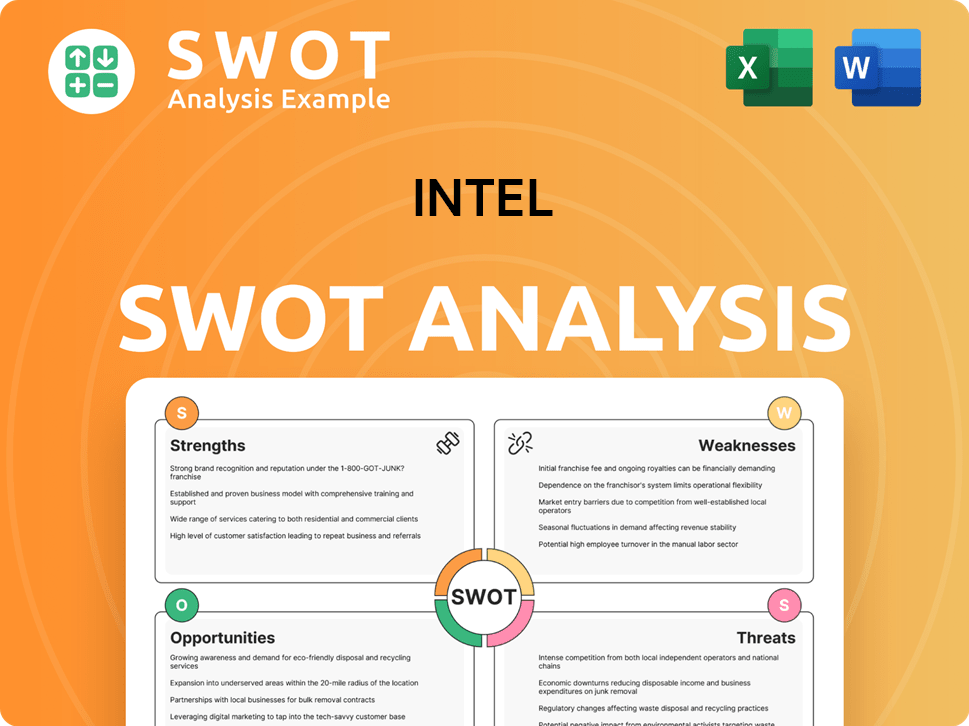
How Does Intel Invest in Innovation?
The core of the Intel growth strategy hinges on technological advancements and innovation. The company is heavily investing in research and development to drive its 'AI Everywhere' strategy, aiming to integrate artificial intelligence across various product lines and applications. This strategic focus is critical for maintaining and expanding its market presence.
Intel's future prospects are closely tied to its ability to capitalize on the growing demand for AI-enabled products and solutions. The company's investments in AI, coupled with its advanced manufacturing capabilities, are designed to position it as a leader in the evolving semiconductor landscape. This approach is aimed at capturing new market opportunities and solidifying its competitive position.
Intel's business model is evolving to meet the demands of a rapidly changing market. The company is focusing on innovation in areas like AI and advanced manufacturing to drive growth and maintain its relevance in the industry. This strategic shift underscores Intel's commitment to adapting to the future of computing.
Intel is targeting the AI PC market aggressively. The goal is to ship over 100 million AI PCs by the end of 2025. This initiative is a key component of their strategy to integrate AI into everyday computing experiences.
Intel is collaborating with over 200 Independent Software Vendors (ISVs). This collaboration aims to optimize software on Intel silicon. The focus is on enabling more than 400 features.
The Data Center and AI (DCAI) business unit saw an 8% year-over-year revenue increase in Q1 2025. This growth reached $4.1 billion. The increase was driven by demand for host CPUs for AI servers and storage compute.
Intel launched Gaudi 3 AI accelerators in late 2024. These accelerators are designed to enhance AI training and inference capabilities. They are positioned to offer a favorable price-to-performance tradeoff.
The 18A process node is a cornerstone of Intel's innovation strategy. This technology is crucial for regaining process leadership. Volume production is on track for the second half of fiscal year 2025.
Intel is committed to an open automotive chiplet platform. This platform allows for the integration of third-party chiplets. It fosters innovation and flexibility within the automotive industry.
Intel's current strategic initiatives focus on AI, advanced manufacturing, and expanding into new markets. These initiatives are critical for its long-term growth and competitiveness. The company is also investing heavily in its data center business and exploring opportunities in the autonomous vehicle market.
- AI Everywhere Strategy: Driving AI integration across all product lines, including PCs and data centers.
- Advanced Manufacturing: Focusing on the 18A process node to regain process leadership.
- Data Center Growth: Expanding its presence in the data center market with innovative solutions.
- Automotive Market: Developing an open automotive chiplet platform to foster innovation.
- Competitive Landscape: Intel's strategy involves competing with AMD and other players through technological advancements and strategic partnerships.
To understand more about Intel's financial performance and business model, you can read this article: Revenue Streams & Business Model of Intel.
Intel PESTLE Analysis
- Covers All 6 PESTLE Categories
- No Research Needed – Save Hours of Work
- Built by Experts, Trusted by Consultants
- Instant Download, Ready to Use
- 100% Editable, Fully Customizable
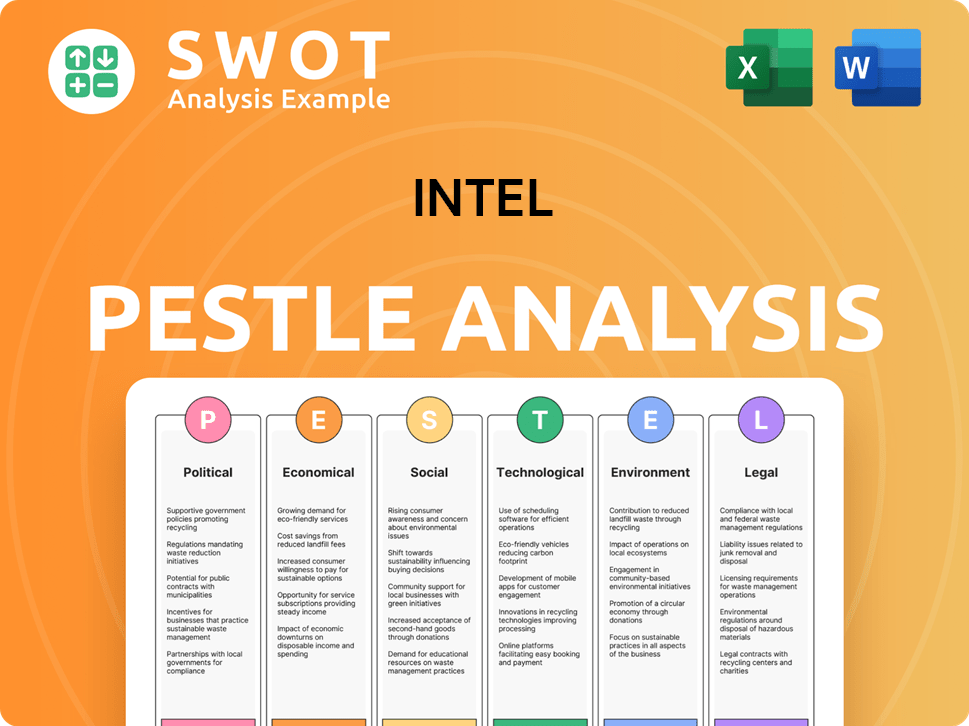
What Is Intel’s Growth Forecast?
The financial outlook for Intel reflects a period of strategic transformation and significant investment, particularly in its foundry business. The company is focused on returning to sustainable growth, despite facing several challenges. Intel's strategy involves cost-cutting measures and a focus on innovation to regain its market position and drive future growth. This involves significant investment in new technologies and manufacturing capabilities.
For the first quarter of 2025, Intel's financial performance showed mixed results. While revenue remained relatively flat year-over-year, the company reported a net loss. This financial performance underscores the challenges Intel faces in the competitive semiconductor market. These challenges are being addressed through strategic initiatives aimed at long-term growth and profitability.
The company's efforts to streamline operations and invest in future technologies are key to its long-term success. The focus on the foundry business and cost optimization are critical components of Intel's growth strategy. Understanding the competitive landscape is crucial for assessing Intel's future prospects, and you can learn more about it from Competitors Landscape of Intel.
Intel reported revenue of $12.7 billion in Q1 2025, which was flat compared to the previous year. This stagnation highlights the competitive pressures within the semiconductor industry. The company's ability to innovate and adapt to market demands will be critical for future revenue growth.
Intel experienced a net income loss of $887 million in Q1 2025, nearly double the loss from Q1 2024. The non-GAAP gross margin was 39.2% in Q1 2025, down from 45.7% in Q4 2023. This decline in profitability reflects the costs associated with strategic investments and market competition.
Intel has forecast Q2 2025 revenue to be between $11.2 billion and $12.4 billion. This projection indicates a cautious outlook for the short term. The company is managing expectations while it implements its growth strategy and invests in future technologies.
Intel has adjusted its capital expenditure target for 2025 to $18 billion, down from an earlier projection of $20 billion. The operating expense target has been reduced to $17 billion for 2025 and $16 billion for 2026. These measures are part of a plan to achieve $10 billion in cost savings by 2025.
Despite recent losses, analysts expect Intel to report diluted earnings per share (EPS) of $0.98 by December 2025. This indicates a potential recovery in profitability. The foundry business is a key investment area, with the aim to break even by the end of 2027.
- Revenue is projected to grow by 6% to $55.84 billion in 2025.
- The foundry business reported a $2.3 billion operating loss in Q1 2025.
- Intel is investing heavily in its foundry business, aiming for it to become profitable.
- Cost-cutting measures include a workforce reduction of approximately 15,000 roles.
Intel Business Model Canvas
- Complete 9-Block Business Model Canvas
- Effortlessly Communicate Your Business Strategy
- Investor-Ready BMC Format
- 100% Editable and Customizable
- Clear and Structured Layout
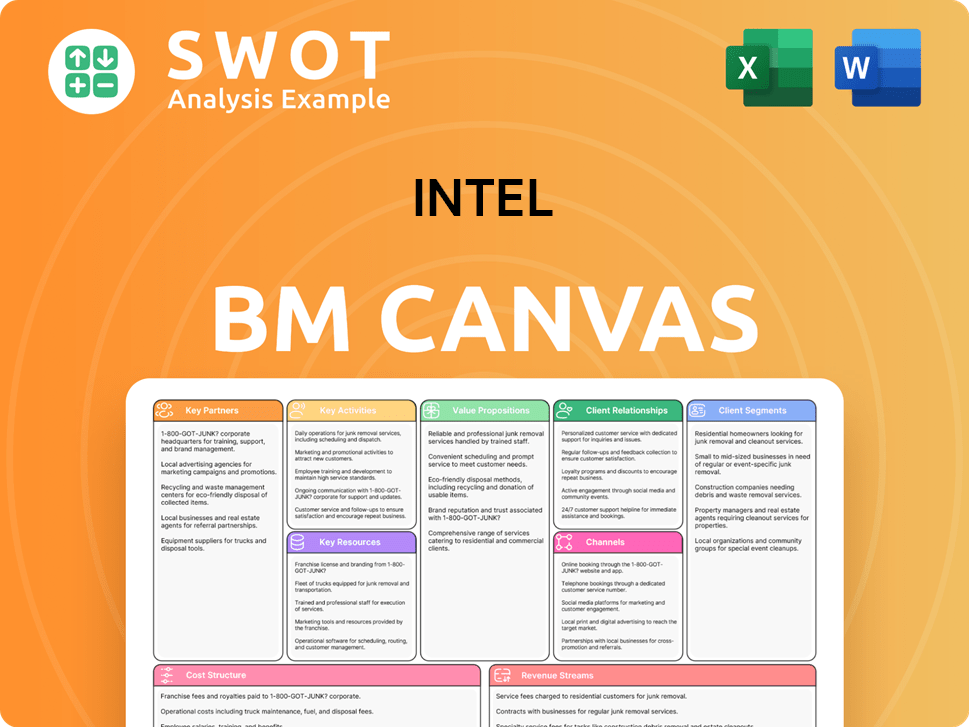
What Risks Could Slow Intel’s Growth?
Several risks and obstacles could influence the Intel growth strategy and its Intel future prospects. These challenges range from intense competition in the semiconductor market to regulatory uncertainties and internal operational issues. Overcoming these hurdles is crucial for the Intel company to achieve its strategic goals and maintain its position in the industry.
One of the primary challenges is the competitive landscape. Rivals like AMD and Nvidia are steadily gaining market share, particularly in the data center and AI markets. The increasing adoption of alternative chip architectures, such as Arm, also poses a threat to Intel's traditional dominance. Addressing these competitive pressures is essential for Intel's sustained growth.
Regulatory changes and trade policies add to the uncertainty. David Zinsner, Intel's CFO, has highlighted that volatile trade policies increase the risk of an economic slowdown. This could lead to reduced investment and spending, impacting Intel's sales. Navigating these regulatory complexities is vital for mitigating financial risks.
Intel faces stiff competition from AMD and Nvidia in the data center and AI markets. Nvidia's dominance in GPUs, especially in AI, presents a significant challenge. The rise of alternative chip architectures like Arm further erodes Intel's market share.
Fluid trade policies from the US and other countries increase the risk of an economic downturn. This uncertainty could lead to reduced business and consumer spending. These regulatory uncertainties can significantly impact Intel's financial performance.
Delays in product rollouts and execution risks, particularly with the 18A process node, could hinder Intel's plans. The foundry business faces challenges, with a reported $2.3 billion operating loss in Q1 2025. Success depends on the readiness of the 18A node.
Leadership changes, such as the departure of CEO Pat Gelsinger in December 2024, have created uncertainty. The dual business model of designing and manufacturing chips has also made Intel less efficient than competitors focusing on one aspect.
Intel's foundry business reported a $2.3 billion operating loss in Q1 2025. The company is aiming for profitability, but the success of the 18A node and customer wins are critical. These financial figures highlight the need for strategic improvements.
The rapid pace of technological change, including advancements in AI and alternative chip designs, could disrupt Intel's market position. Intel must continue to innovate to stay competitive.
The company faces challenges in maintaining its Intel market share due to competition from AMD and Nvidia. Nvidia's dominance in GPUs, especially in the AI sector, poses a significant hurdle. The rise of alternative chip architectures, such as Arm, also contributes to the erosion of Intel's traditional dominance.
Intel innovation is crucial for staying competitive. The company needs to invest heavily in research and development to keep pace with technological advancements. The development of advanced process nodes and new chip designs is essential for maintaining a competitive edge. For more information, you can read a Brief History of Intel.
The Intel business model, which combines chip design and manufacturing, presents both advantages and disadvantages. While this model allows for greater control over the production process, it also requires significant capital investment and presents operational complexities. Competitors focusing on either design or manufacturing may operate more efficiently.
Intel's financial performance is closely watched by investors and analysts. The company's foundry business reported a $2.3 billion operating loss in Q1 2025. Achieving profitability in the foundry business is critical for overall financial health and future growth.
Intel Porter's Five Forces Analysis
- Covers All 5 Competitive Forces in Detail
- Structured for Consultants, Students, and Founders
- 100% Editable in Microsoft Word & Excel
- Instant Digital Download – Use Immediately
- Compatible with Mac & PC – Fully Unlocked
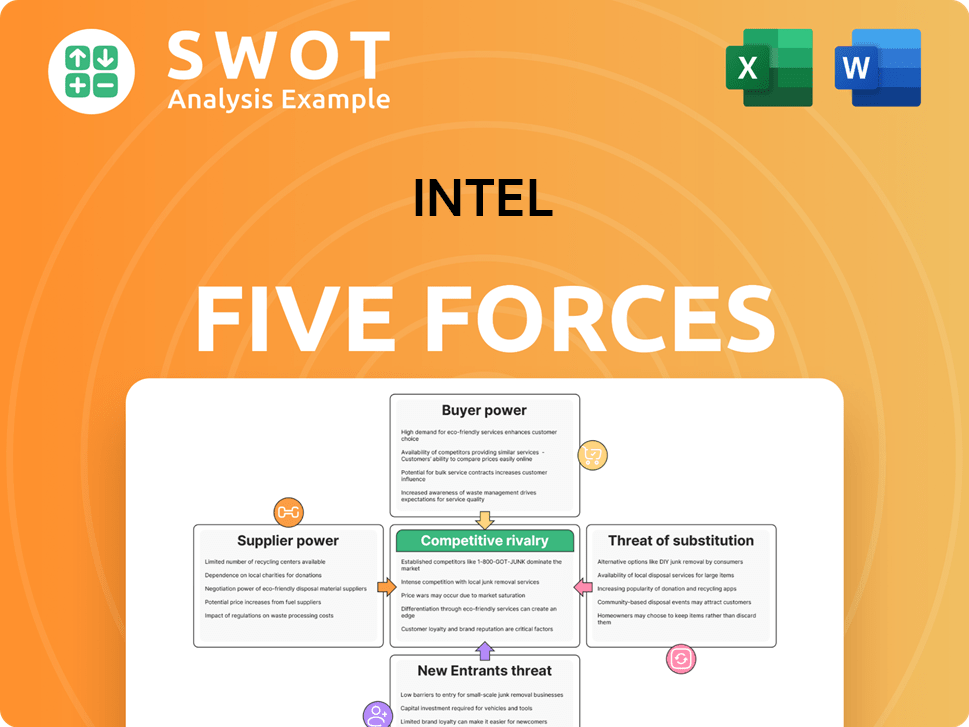
Related Blogs
- What are Mission Vision & Core Values of Intel Company?
- What is Competitive Landscape of Intel Company?
- How Does Intel Company Work?
- What is Sales and Marketing Strategy of Intel Company?
- What is Brief History of Intel Company?
- Who Owns Intel Company?
- What is Customer Demographics and Target Market of Intel Company?
Disclaimer
All information, articles, and product details provided on this website are for general informational and educational purposes only. We do not claim any ownership over, nor do we intend to infringe upon, any trademarks, copyrights, logos, brand names, or other intellectual property mentioned or depicted on this site. Such intellectual property remains the property of its respective owners, and any references here are made solely for identification or informational purposes, without implying any affiliation, endorsement, or partnership.
We make no representations or warranties, express or implied, regarding the accuracy, completeness, or suitability of any content or products presented. Nothing on this website should be construed as legal, tax, investment, financial, medical, or other professional advice. In addition, no part of this site—including articles or product references—constitutes a solicitation, recommendation, endorsement, advertisement, or offer to buy or sell any securities, franchises, or other financial instruments, particularly in jurisdictions where such activity would be unlawful.
All content is of a general nature and may not address the specific circumstances of any individual or entity. It is not a substitute for professional advice or services. Any actions you take based on the information provided here are strictly at your own risk. You accept full responsibility for any decisions or outcomes arising from your use of this website and agree to release us from any liability in connection with your use of, or reliance upon, the content or products found herein.